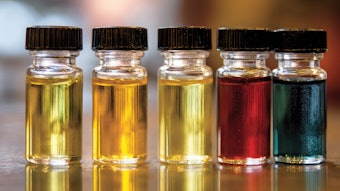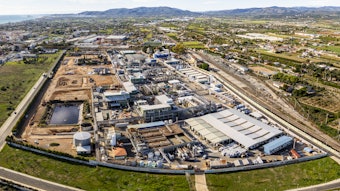Dramatic reductions in characterization and analysis times for essential oils were achieved using highspeed gas chromatography (HSGC) and time-of-flight mass spectrometry (TOFMS). High-speed separations were achieved with relatively short capillary separation columns operated with high carrier-gas flow rates and fast temperature programming. Unique features of TOFMS include high spectral acquisition rates and spectral continuity (constant ion-abundance ratios across chromatographic peak profile). These features allow for completely automated peak finding and spectral deconvolution of relatively narrow and severely overlapping chromatographic peaks from completely unknown mixtures. This reduces the chromatographic resolution requirements, and can result in order-of-magnitude reductions in the time required for mixture characterization. For HSGC analysis of characterized samples, selectivity is enhanced by the use of programmable carrier gas flow in a series-coupled ensemble consisting of a polar and a non-polar column. A valve connecting the column junction point to a ballast chamber containing carrier gas at the GC inlet pressure is used to stop the flow in the first column for short, programmed intervals in order to achieve greater separation of targeted component pairs that are separated by the first column in the ensemble, but co-elute from the ensemble. High-speed characterization and analysis of grapefruit oil is used to demonstrate these technologies. Using a temperature-programming rate of 50oC/min, complete characterization and analysis are achieved in less than 200 s.
Essential oils are botanical substances widely used for their flavor and fragrance qualities. Hundreds of these oils are commercially available. Some of these natural products are highly valued as commodity and specialty materials for the flavor, fragrance and medicinal markets. The market value of these materials is strongly linked to composition, and adulteration in the service of enhanced profitability is not infrequent. Because many of these materials are used as flavorings and medicinal agents, health and safety issues are of concern.
For these reasons, the analytical chemistry of essential oils is very important, and the literature abounds with studies related to the characterization and quantitative analysis of these materials. The difficulties in their analysis arise from the large number of components, many of them present at low concentrations, and large variations in composition with growing conditions, location and processing methods. Since many of the constituents have structural similarities, characterization of the mixture components can be difficult. For example, essential oils contain many terpenes and oxygen-containing terpene structures. The oxygenated compounds are often responsible for the flavor and fragrance characters of specific oils. Terpenes can be rapidly oxidized by air with the development of unpleasant flavors and odors.










